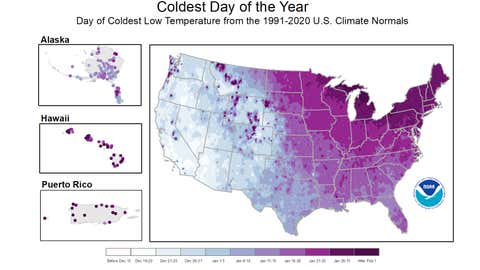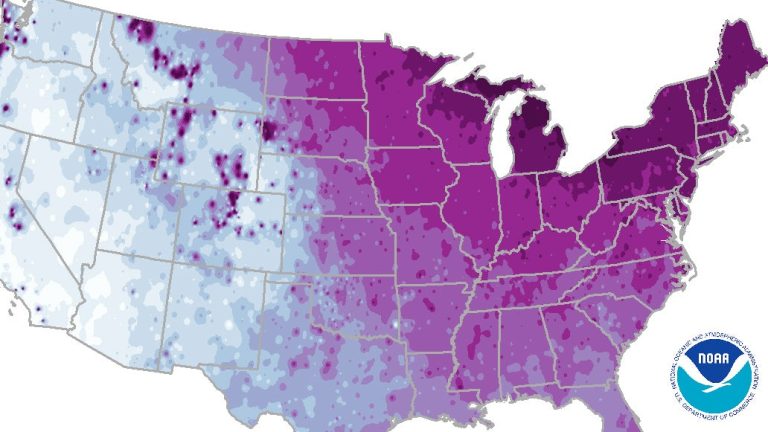- Mid-to-late January is the average coldest time of the year in most of the Midwest, South, and East.
- In parts of the West it is usually earlier in December or early January.
- Some winters feature the coldest air of the season earlier or later than usual.
A large blast of Arctic air gripping the United States through mid-January is a reminder that we are headed into the coldest weather time of the year in many parts of the country.
(More: Sinking Arctic threatens records in the Deep South)
NOAA's map shows when the average coldest day of the year typically occurs in the United States: From the Northern Plains to the Midwest, Southeast, and Northeast, the last two weeks of January are typically the coldest time of the year. Typically only some parts of northern Michigan are colder after February 1st.
From the Front Range of the Rockies westward, this coldest time of the year is usually very early in December or early January.
The reason for this east-west discrepancy is the frequent descent of frigid Arctic air over Alaska and Canada into the Midwest and Northeast in January. West of the Rocky Mountains, such mid-winter Arctic dives are less frequent. Instead, Pacific storms can push cooler air to the west, even in the heart of winter.


Temperatures at this time of year are usually the coldest, based on 30-year average temperatures from 1991 to 2020.
(NOAA)
In Alaska, the coldest time of the year is usually January. In Hawaii, most of the island chain experiences the coldest day, relatively speaking, in February or early March.
Maps are derived from US climate benchmarks provided by the National Centers for Environmental Information (NCEI): The dataset consists of the latest 30-year average of weather data, including daily high and low temperatures, for various cities across the United States.
The map shows the average time frame in which the coldest air of the season arrives. In any given year, the actual coldest day for your area may occur before or after the time shown on the map.
The coldest temperatures of the year usually occur when Canada's frigid Arctic air is drawn south into the United States. Outbreaks in the Arctic usually occur at the average coldest time of the year, as we are seeing this month.


Coldest average daily low temperature of the year, based on average data from 1991-2020.
(Data: NOAA/NWS)
Recent years show that the atmosphere can deliver cooler air sooner or later than average: A severe cold outbreak in early March 2019 was the coldest of the season in Great Falls, Montana (minus 32 degrees); Dallas (21 degrees); Wichita, Kansas (2 scores).
Just last winter, late December brought the coldest air to many places, including Chicago (8 degrees below zero); Nashville, Tennessee, (minus 1 degree); and Atlanta (8 degrees).
All-time record lows in December, January or February are common in many cities: Boston, New York City's Central Park, and Philadelphia all set their records for cold outbreaks on February 9, 1934. Washington, D.C., set its record on February 11, 1899.
Several Midwestern cities set their records in January, including Chicago (Jan. 20, 1985), Cleveland (Jan. 19, 1994) and Minneapolis-St. Paul (January 21, 1888).
In the South, the January 1985 cold outbreak set records that still stand in Charlotte and Raleigh, North Carolina; Charleston, South Carolina; And Nashville, Tennessee. However, the historic cold outbreak of February 1899, arguably the greatest in modern history, remains the all-time record holder in Atlanta. Dallas. Little Rock, Arkansas; and Tallahassee, Florida, among other cities.
The all-time western record cold range varied from December 11, 1932 in downtown San Francisco to February 15, 1936 in Great Falls, Montana. Both Anchorage (minus 34 degrees) and Fairbanks (minus 66 degrees) set their all-time cold records in early and mid-January.


All-time record lows for a number of locations across the United States
(Data: NOAA/NWS)
Chris Dolce He has been a senior meteorologist at Weather.com for over 10 years after starting his career with The Weather Channel in the early 2000s.
The Weather Company's primary journalistic mission is to report on breaking weather news, the environment, and the importance of science in our lives. This story does not necessarily represent the position of our parent company, IBM.

